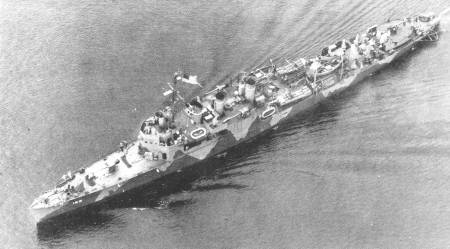

Design History
The Caldwell design set the general outline of the new destroyer. In the older ship, the previously employed forecastle, the drop after the deckhouse, and through horizontal main deck after that, was abandoned in favor of a different solution giving more strength to the ship, with a flush main deck sloping from bow to stern, so as to keep the relative heights of the previous forecastled destroyers, and a sloped keel to retain the necessary submergence of propellors in a very shallow-draft hull. The new design came out, thanks to there being effectively more steel used, somewhat heavier than the 1,000-ton classes before it, but would probably be a better, steadier sea-boat, even if wetter on the bows.
The resultant Caldwell class of six ships served, when the necessity arose of greatly increasing destroyer production, as the basis for the new design. The Wickes class, 50 destroyers of which were authorized in the 1916, 20 of which were also funded under the FY17 appropriations. Also providing for "Naval Emergency Funds", Congress left the President (Woodrow Wilson) to chose to built additional destroyers virtually at his discretion. By May 1916, 61 of the new ships had been laid down.
The new ships carried the same armament as the previous Caldwell class, which carried the same armament as the 1,000 tonners, alas with the higher speed in mind possessed greater power, and slightly greater displacement. Furthermore, the gun arrangement somewhat differed from the previous 1,000 tonners, with one on the stern, one on the bow, and one on each side on the deckhouse between the second and third funnels. Otherwise similar, the new class was sufficiently close to the previously built destroyer that there were few problems with the yards that were to build the ships. Two yards drew up the final designs, Bath Iron Works and Bethlehem Steel, each choosing different boiler and turbine contractors. Bethlehem's choice of Yarrow boilers proved unfortunate, since the Yarrows deteriorated quickly. Furthermore, the differences in propulsion systems (there were ships without geared turbines and ships with them, four different boiler manufacturers and three for turbines) and workmanship resulted in greatly varying endurances in the ships, the Bath ships generally longer-ranged than their Bethlehem cousins.
In the course of World War I, 111 Wickes class ships were constructed, most too late to see service in that war.
Modification History
Service History
The Wickes class was the oldest class of the so-called "flushdeckers" to see service in World War II. Its direct predecessor was Destroyer 1916, the Caldwell class, from which no ship survived to participate in the Pacific War.
The Wickes class resulted from the peculiar requirements the war made in the U.S. ship-building industry. Early in 1916, Congress had passed an act calling for the enlargement of the fleet to comprise enough warships to be able to deal with all foes, in the words of the time, a "fleet second to none". Part of the orders called for the ten Omaha class light cruisers, another for six Constellation class battlecruisers (later to become the foundation for Lexington and Saratoga), and the new destroyer class was to operate with these ships, necessitating a maximum speed resmbling theirs - roughly 35 knots.
The U.S. Navy recommissioned the better part of the old vessels for major redesigns in 1941: as anti-submarine escorts with additional depth charges, hedgehogs, and sonars, one boiler less and more bunker oil; as fast transports (APDs); as fast minesweepers. All ships remaining in service through World War II received air and surface search radar systems.
The Wickes class, the first batch of the U.S. flushdeckers, saw extensive service through the between-wars period. In the late 1920s, those Wickes class ships built to the Bethlehem design (a total of 60) were scrapped as their Yarrow-type boilers were used up and re-boilering them was a pointless endeavour. Decommissioning most Wickes class ships in the 1930s, as the new destroyers arrived in sufficient numbers to replace the old, and by-now obsolete, destroyers. However, the outbreak of war in Europe made it quickly clear the there would yet be use for the old ships. 22 Wickes class were transferred to the British under the Destroyers-for-Bases-Deal of 1940, the remaining Wickes class ships receiving above-mentioned modifications. APDs served in the Pacific to raiding troops in advance of invasions, to supply garrisons, and for various other tasks, together with the fast minesweepers. Most ASW variants of the Wickes class served in the Atlantic. Unmodified ships served as fleet destroyers in backwaters (especially the Aleutians) and as patrol and escort ships (witness the U.S.S. Ward of Pearl Harbor fame). Despite their age and obsolete design, the ships performed admirably.
Ships in class:
DD-118 Lea
DD-118 Badger
DD-128 Babbitt
DD-137 Kilty
DD-138 Kennison
DD-139 Ward
DD-142 Tarbell
DD-144 Upshur
DD-145 Greer
DD-147 Roper
DD-148 Breckinridge
DD-149 Barney
DD-150 Blakely
DD-151 Biddle
DD-152 Du Pont
DD-153 Bernadou
DD-154 Ellis
DD-155 Cole
DD-156 J. Fred Talbott
DD-157 Dickerson
DD-158 Leary
DD-159 Schenck
DD-160 Herbert
DD-164 Crosby
|
|
Displacements:
Standard: 1,208 tons Full: 1,597 tons Length: 95,8m / 314ft 4" Beam: 9,43m / 30ft 11,5" Draft (Full Load): 3,45m / 11ft 4,25" Crew (Officers/Men): 6/108 Endurance: 3800nm at 15 knots Speed: 35 knots |
|
|
Belt: No belt armor
Deck: No deck armor Barbettes: No barbette armor Conning Tower: No conning tower armor |
|
|
(As designed):
Main: 4 x 102mm L/50, in four single mounts: one on the forecastle, one on the quarterdeck, two in the waist abaft no. 2 stack. Secondary: None AA: 1 x 76mm L/23 Torpedoes: 12 533mm torpedo tubes in four triple mounts, two on each side. Depth Charges: 2 x depth charge track (Ward, December 1941):
(Chew, August 1945):
|